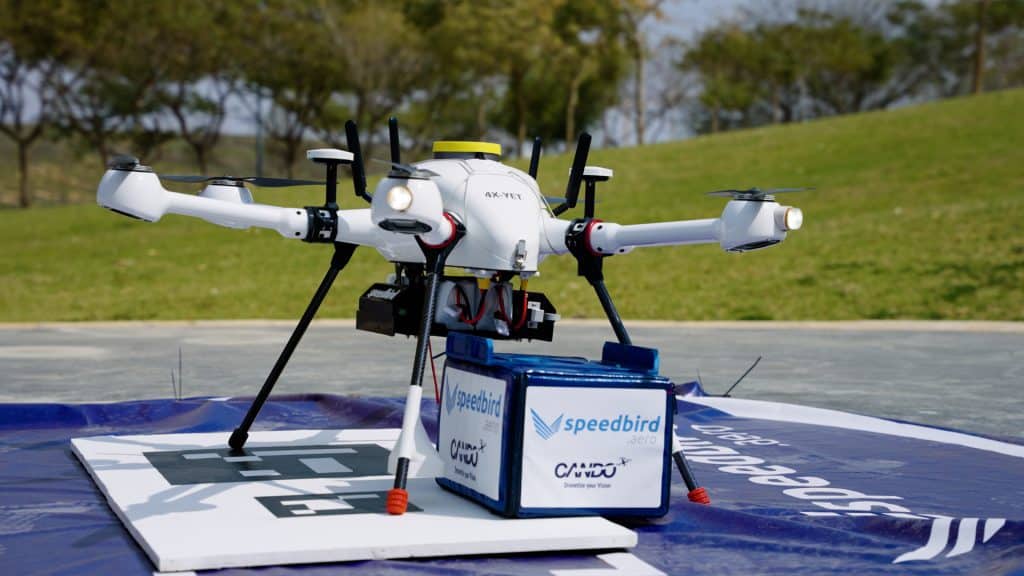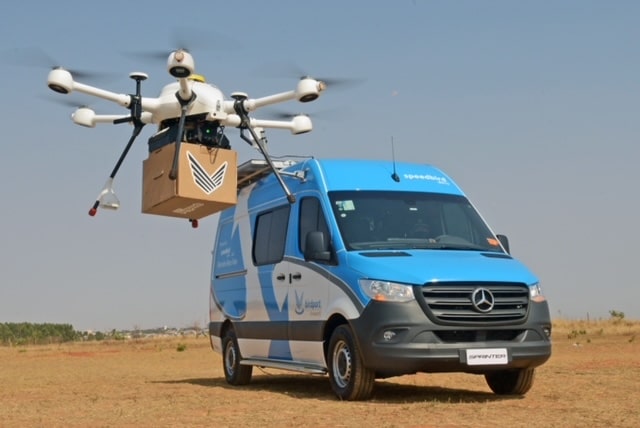Speedbird Aero and Elsight Deliver on Reliability…Together
January 31, 2023 | Dawn Zoldi

Scalable drone delivery operations, especially those involving beyond visual line of sight (BVLOS) flights, hinge on safety. This requires, among other things, the right hardware coupled with connection confidence. Two companies from across the globe, Brazilian Speedbird Aero, and Israel-based Elsight, have joined forces to deliver on the promise of reliability, literally and figuratively. This is their story.
The Hardware
From the start, Speedbird designed its drones to deliver. The company’s co-founders Samuel Salomao, a software engineer, and Manoel Coelho, MBA , originally worked for a telemedicine company in Phoenix, Arizona. Inspired by the promise of delivering medicines and lab specimens across healthcare deserts around the world by drone, but unable to secure local funding for their dream, they dropped everything, went back to Brazil (home of aircraft manufacturing giant Embraer) and created Speedbird in 2018.
After extensive review of the available commercial products, the two decided to develop their own delivery drones from scratch. Today, Speedbird offers three different models. “We created three different drones because in Brazil, we have lots of companies that have different needs for different projects with different payloads to carry,” Coelho explained.
Speedbird built its first drone, the DLV1, for smaller payload logistics. This lightweight axle rotorcraft can carry up to three kilograms (6.6 pounds) of payload round trip. The DLV1 was the first drone to receive type certification by the National Civil Aviation Agency (Agência Nacional de Aviação Civil or ANAC), which has bilateral agreements with the Federal Aviation Administration (FAA) and the European Aviation Safety Agency (EASA). Other firsts for the DLV1 include ANAC approvals for BVLOS operations, including operations at night. Flights over people with the DLV1 start this month. Next up: one-to-many ops.
 The company created the DLV2 as an extension of the DLV1 to focus on heavier cargo. This axle rotor can fly with five motors and carry up to eight kilograms (17.6 pounds) of payload. It has three times the round trip range of the DLV1. ANAC also certified this aircraft.
The company created the DLV2 as an extension of the DLV1 to focus on heavier cargo. This axle rotor can fly with five motors and carry up to eight kilograms (17.6 pounds) of payload. It has three times the round trip range of the DLV1. ANAC also certified this aircraft.
Speedbird’s DLV4, a fixed wing electric vertical takeoff and landing (eVTOL) platform can fly medium range distances, up to 100km, ideal for intercity and interstate logistics. The company expects ANAC certification for this drone imminently.
“We created all of our hardware and software to allow connectivity with a wide variety of partners, from delivery partners to UAS traffic management (UTM) companies,” explained Coelho. He continued, “We needed to maintain reliable connectivity at significant distances, in remote regions and over water. We needed to solve that.”
Enter: Elsight.
The Connection Confidence
Elsight got its start designing video streaming services for the Israeli Defense Forces and Israeli police forces. “Along the way, we figured out that we had created an extremely powerful communication device for command and control (C2),” said Yoav Amitai, the company’s CEO. This ultimately led Elsight to create their seminal product, Halo, specifically for the uncrewed and robotics industry.
Amitai explained, “What we’re doing with Halo is multiplexing or aggregating multiple communications networks concurrently.” He continued, “We can combine any point-to-point communications, from cellular operators such as Verizon and T-Mobile, to satellite communications. The Halo will sniff out the strongest signal and switch to it autonomously.” (For more on Halo, see this DroneLife exclusive)
In 2021, Elsight’s Halo solution proved 99.9% reliable during over ten thousand BVLOS drone deliveries during Israel’s 8-phase National Drone Initiative called NAAMA. “In late 2021 we participated in NAAMA Phase 3, where drone deliveries took over Tel-Aviv’s metropolitan skies, delivering ice cream, sushi, beer, blood samples and much more across a large, populated area,” lauded Ben Gross, Elsight’s Director of Marketing.
And that’s where Speedbird met Elsight.
The Partnership
NAAMA aimed to simulate thousands of flights from multiple operators within short periods of time in the same airspace. NAAMA leaders (Israel’s Innovation Authority, Civil Aviation Authority, Ministry of Transport, Ayalon Highways) invited Speedbird as the first foreign company to the demos.
Coelho recalled, “While we had lots of difficulties in Brazil with communications issues, the challenges in Israel were very different. We did not have good GPS systems in the southern hemisphere at home, but we were able to solve that. So we were confident when we left Brazil for Israel. Once we got there, we experienced GPS jamming, which we had never experienced in Brazil. Israel it was a rude awakening.”
The one SIM card Speedbird had was not sufficient. Israeli regulators insisted on reliable connectivity. They introduced Speedbird to Elsight.
“It was Friday afternoon, and we received notice of some communications requirements from the regulatory body,” Amitai said. “We met Speedbird. And the rest is history.”
Elsight came in that same day, and with another Israeli company, Cando Drones, they opened up the Speedbird drone and installed Halo. “Just like that, it started to work!” exclaimed Coelho. He called his partner in Brazil immediately and said, “We need to do this with Elsight. I want the best in drones. I want the best of the technologies. And this is it.”
After the installation of Halo, Speedbird successfully flew its drone DLV1 during the NAAMA trial, guaranteeing connectivity at all times during flights.
The two companies remain strong partners.
Today and Tomorrow
Together, Speedbird works with Elsight everywhere they go. “We work very closely with our partners to ensure that no matter where we operate, we have the right solutions. Halo allows us to use the same technology globally for reliable connections. It’s plug and play. It’s worldwide. It’s quite capable,” Coelho said.
According to Coelho, Speedbird started its international expansion with Israel. “Israel was a phenomenal experience for Speedbird. It was a tough location with high expectations of performance. We found great partners there in Elsight, Cando and High Lander, which got us ready for the international arena,” he said. “With Elsight, in particular, we got a company that can accompany us everywhere so we don’t have to change our infrastructure, but still have reliable C2.”
 Speedbird now operates and serves multiple customers not only in Brazil, but in Israel, the U.S. and other parts of Latin America. The company’s 2022 highlights include participating in Eve Air Mobility’s first North American urban air mobility (UAM) simulation in Chicago and collaborating with Spright in transporting medical samples to and from the Illinois Medical District.
Speedbird now operates and serves multiple customers not only in Brazil, but in Israel, the U.S. and other parts of Latin America. The company’s 2022 highlights include participating in Eve Air Mobility’s first North American urban air mobility (UAM) simulation in Chicago and collaborating with Spright in transporting medical samples to and from the Illinois Medical District.
This year, Speedbird expects to keep flying BVLOS across the U.S. and opening up an assembly plant in North Carolina. “We are excited to come back to the U.S. We’re excited about what’s happening in the industry around the world. It makes us very proud to be part of a global group of tech pioneers. We believe in 2023 the industry is really going to take off!”
For its part, Elsight’s Halo contributes to tens of thousands of flight hours monthly, on multiple different platforms worldwide. In just two and a half years after the product’s commercial release, the company has expanded its business model to provide.
“Halo as a service” (HaaS), a lower cost monthly pay-per-use subscription. “It’s a monthly expense,” Amitai said, “but customers only pay for those drones that they are actually using to generate revenue. We hope this will help our partners accelerate their businesses.”
On the technology side, Elsight continues adding additional features to Halo, from enhancing 5G with T-Mobile and infusing remote identification capabilities into it, to pushing out remote software updates “Tesla-style.”
For Elsight, it’s all about putting the customer – and safety – first. “At the end of the day, we will never grow this industry without the right safety measures in place. And connectivity is key to any system that needs to be either remotely or autonomously operated. You need to have a strong C2 link across your entire mission to successfully complete it,” Amitai noted. “Elsight exists to make sure that you will be able to reach the other side safely and go back home or go to your next station without any fears about connectivity. We’ve got you covered.”
Both companies expect to make some big announcements this year, including about additional partnerships. Both CEOs believe that being a part of this industry is about being part of historical change. Both are always looking to work with as many partners as possible to become part of creating that history…together.
 To learn more or become partners with Speedbird Aero and Elsight contact Eloisa Rios (Speedbird) and Nimrod Blinder (Elsight).
To learn more or become partners with Speedbird Aero and Elsight contact Eloisa Rios (Speedbird) and Nimrod Blinder (Elsight).
And if you missed Manoel or Yoav on the Dawn of Drones podcast, presented by AUVSI, watch that show on demand here.
- Podcast

